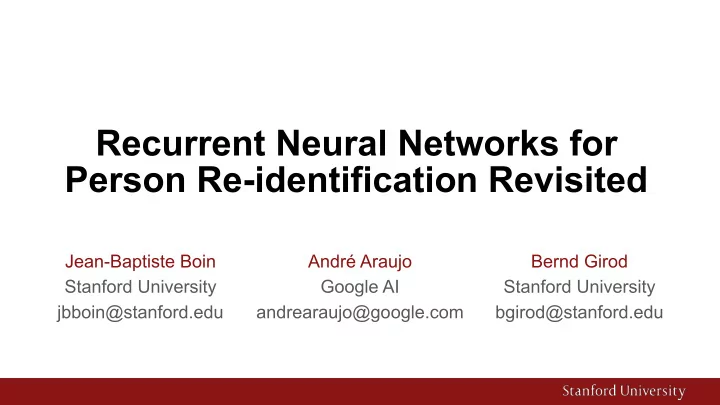

Recurrent Neural Networks for Person Re-identification Revisited Jean-Baptiste Boin André Araujo Bernd Girod Stanford University Google AI Stanford University jbboin@stanford.edu andrearaujo@google.com bgirod@stanford.edu
Person video re-identification ▪ Goal: associate person video tracks from different cameras ▪ Applications: › Video surveillance › Home automation › Crowd dynamics understanding Image credit: PRID2011 dataset [Hirzer et al. , 2011] 2
Person video re-identification: challenges Viewpoint changes Lighting variations Clothing similarity Background clutter and occlusions Credit: iLIDS-VID dataset [Wang et al. , 2014] 3
Framework: re-identification by retrieval Sequence feature extraction Sequence feature extraction Sequence feature Database extraction Sequence (Camera A) matching by Sequence feature extraction feature similarity Sequence feature extraction Sequence feature Query extraction (Camera B) 4
Related work Sequence feature ▪ Most common setup › Frame feature extraction: CNN Mean pooling › Sequence processing: RNN › Temporal pooling: mean pooling RNN RNN RNN › [McLaughlin et al., 2016], [Yan et al., 2016], [Wu et al., 2016] CNN CNN CNN 5
Related work Sequence feature ▪ Most common setup › Frame feature extraction: CNN Mean pooling › Sequence processing: RNN › Temporal pooling: mean pooling RNN RNN RNN › [McLaughlin et al., 2016], [Yan et al., 2016], [Wu et al., 2016] ▪ Extensions CNN CNN CNN › Bi-directional RNNs [Zhang et al., 2017] › Multi-scale + attention pooling [Xu et al., 2017] › Fusion of CNN+RNN features [Chen et al., 2017] See review paper [Zheng et al., 2016] 6
Outline ▪ Feed-forward RNN approximation with similar representational power ▪ New training protocol to leverage multiple video tracks within a mini-batch ▪ Experimental evaluation ▪ Conclusions 7
RNN setup o (t-1) o (t-1) tanh W s f (t) o (t) CNN v s W i o (t+1) o (t) 8
Proposed feed-forward approximation (1/2) ▪ “Short-term dependency” approximation Disregard terms from step (t-2) in output from step (t) 9
Proposed feed-forward approximation (2/2) ▪ “Long sequence” approximation Using approximation from previous slide Disregard edge cases (first and last frame) since videos are long 10
Proposed feed-forward approximation: new block RNN Ours: FNN o (t-1) tanh W s tanh W s õ (t) o (t) f (t) f (t) W i W i o (t) ▪ Same memory footprint ▪ Direct mapping between RNN and FNN parameters 11
Training pipeline ▪ Training data Frames Video tracks Video tracks (camera A) (camera B) 12
Training pipeline: RNN baseline ▪ SEQ : load sequences of consecutive frames in mini-batch Video tracks Video tracks (camera A) (camera B) 13
Proposed FNN training pipeline ▪ FRM : load independent frames ▪ Load images from many more identities in a mini-batch (same memory/computational cost) SEQ (baseline) FRM (ours) 14
Data and experimental protocol ▪ Dataset 1: PRID2011 [Hirzer et al., 2011] › 200 identities, average length: 100 frames / track ▪ Dataset 2: iLIDS-VID [Wang et al., 2014] › 300 identities, average length: 71 frames / track ▪ Data splits › Train/test set with half of the identities each › Performance averaged over 20 splits ▪ Evaluation metric: CMC (equivalent to mean accuracy at rank k) 15
Experiment: Influence of the recurrent connection ▪ Train weights on RNN-SEQ (RNN architecture, SEQ training protocol) ▪ Evaluate on RNN and FNN using the weights directly ( no re-training ) ▪ Same performance obtained PRID2011 dataset 16
Experiment: Comparison with baseline ▪ FNN-FRM (ours) outperforms RNN-SEQ ▪ More diversity in mini-batches allows for a much better training 17
Comparison with baseline (comprehensive) ▪ Our method outperforms the baseline for all ranks in both datasets CMC values (in %) 18
Comparison with state-of-the-art RNN methods ▪ Our method is considerably simpler than the other state-of-the-art RNN methods compared but still achieves comparable performance results CMC values (in %) 19
Conclusions ▪ Simple feed-forward RNN approximation with similar representational power ▪ New training protocol to leverage multiple video sequences within a mini-batch ▪ Results significantly and consistently improved compared to baseline ▪ Results on par or better than other published work based on RNNs, with a much simpler technique ▪ Faster model training compared to RNN baseline 20
Questions?
Recommend
More recommend